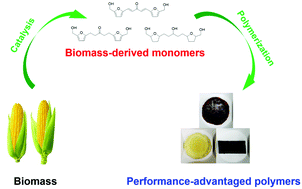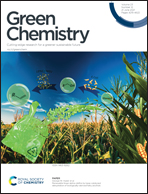Synthesis of performance-advantaged polyurethanes and polyesters from biomass-derived monomers by aldol-condensation of 5-hydroxymethyl furfural and hydrogenation†
Abstract
Functional polyurethanes and polyesters with tunable properties were synthesized from biomass-derived 5-hydroxymethyl furfural (HMF)–acetone–HMF (HAH) monomers. HAH can be selectively hydrogenated over Cu and Ru catalysts to produce partially-hydrogenated (PHAH) and fully-hydrogenated (FHAH). The HAH units in these polymers improve the thermal stability and stiffness of the polymers compared to polyurethanes produced with ethylene glycol. Polyurethanes produced from PHAH provide diene binding sites for electron deficient C![[double bond, length as m-dash]](https://www.rsc.org/images/entities/char_e001.gif) C double bonds, such as in maleimide compounds, that can participate in Diels–Alder reactions. Such sites can function to create crosslinking by Diels–Alder coupling with bismaleimides and can be used to impart functionality to PHAH (giving rise to anti-microbial activity or controlled drug delivery). The symmetric triol structure of FHAH leads to energy-dissipating rubbers with branched structures. Accordingly, the properties of these biomass-derived polymers can be tuned by controlling the blending ratio of HAH-derived monomers or the degree of Diels–Alder reaction. The polyester produced from HAH can be used in packaging applications.
C double bonds, such as in maleimide compounds, that can participate in Diels–Alder reactions. Such sites can function to create crosslinking by Diels–Alder coupling with bismaleimides and can be used to impart functionality to PHAH (giving rise to anti-microbial activity or controlled drug delivery). The symmetric triol structure of FHAH leads to energy-dissipating rubbers with branched structures. Accordingly, the properties of these biomass-derived polymers can be tuned by controlling the blending ratio of HAH-derived monomers or the degree of Diels–Alder reaction. The polyester produced from HAH can be used in packaging applications.



 Please wait while we load your content...
Please wait while we load your content...
